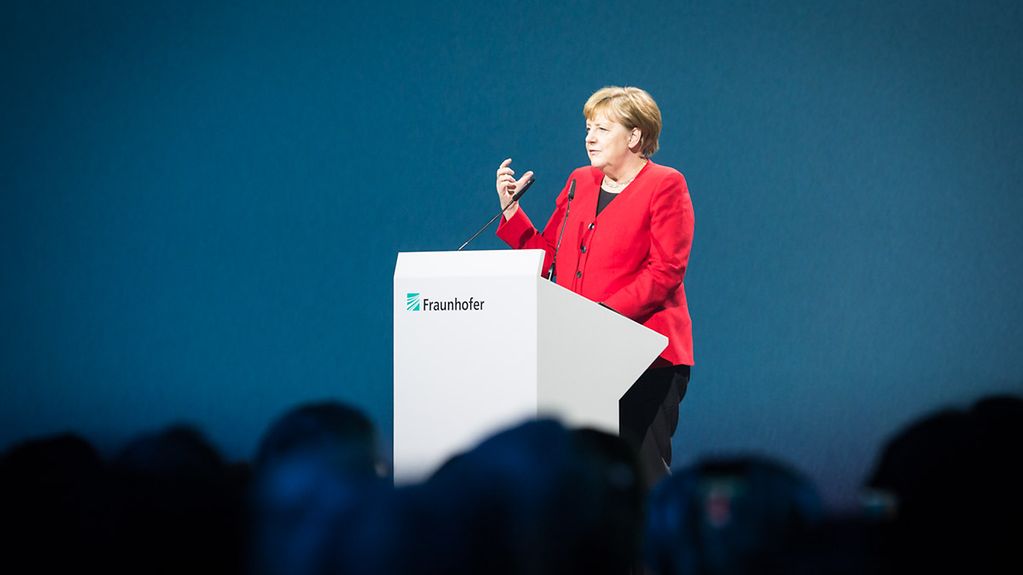70th anniversary of the Fraunhofer Society
Chancellor Angela Merkel has announced a significant increase in German research spending. By 2025 spending is to rise to 3.5% of GDP, announced the Chancellor at the celebrations to mark the 70th anniversary of the Fraunhofer Society.
3 min reading time

In 2017 Germany already invested three per cent of GDP in research
Photo: Bundesregierung
Promising forward-looking technologies where more research is needed include artificial intelligence and electric mobility, said the Chancellor. Although Germany has lost out to Asian suppliers in the development of battery cells, Europe has the chance to regain ground in the further development of battery technology. "If we class this as the most important project in our shared European interest, we have a chance."
Angela Merkel continued, "Europe can only be as innovative as the individual countries that make up Europe. Germany has an especially important part to play in this, because we are the largest economy in Europe. That means that it is good that we are one of the five countries in the world that spend most on research and development." In 2017, she reported, Germany achieved the goal it set itself for the first time, and invested 3% of GDP (gross domestic product) in research and development.
Research for enhanced competitiveness
With its applied research and key technologies for the future, the Fraunhofer Society plays a key part in the innovation process in Germany and in Europe. At the anniversary celebrations the Chancellor praised the contribution made by Fraunhofer research institutes to addressing the challenges of society.
Thanks to research and innovation, Germany is a world leader in terms of competitiveness. This is demonstrated by the consistently high share of research-intensive products that Germany exports.
Never before has so much been invested in research and development as today. The state, the private sector and the science and research community have consistently increased spending in recent years.
In 2017 research and development spending totalled 16.6 billion euros, with a sum of around 9.9 billion euros earmarked for the Pact for Research and Innovation alone. Spending was to be further increased in 2018 (to about 18.1 billion euros) and 2019 (to around 19.6 billion euros).
Non-university research facilities
Facilities like the Fraunhofer Society are essential pillars of research in Germany. The society operates 72 institutes and research facilities, whose research projects embrace the full spectrum of fundamental research. Their focus lies in the fields of resource-oriented production, transport and mobility, energy and housing, information and communication, protection and security, and health, nutrition and the environment.
Along with client and project partners, the Fraunhofer institutes are developing and optimising procedures, products and plant for use in industry and for market.
Almost 24,000 scientists work for the Fraunhofer Society.
Research institutes accelerate innovation
With their research and development work, the Fraunhofer institutes are contributing to upholding competitiveness in Germany and in Europe. They foster innovation, enhance technological performance, increase acceptance for modern technology, and provide training and upgrading for young scientists and technical staff.
To help them in their work, the German government provides funding for universities of applied sciences, research and scientific facilities and comparable institutions outside the private sector. On a case by case basis, the government can assume up to 100% of project-related expenditure (in the case of the Helmholtz centres and the Fraunhofer Society eligible project-related costs), in compliance with the requirements of EU law regarding state aid.
Non-private-sector research projects at universities of applied sciences and university hospitals are also eligible to receive a flat-rate project assistance of 20% in addition to the eligible costs. Assistance is generally provided for a period of three years.
Tax incentives for R+D in small and medium enterprises (SME)
The Chairman of the Commission of Experts for Research and Innovation, Professor Dietmar Harhoff, proposed back in February, "Germany should use tax incentives to foster research and development in small and medium enterprises, as most industrialised states already do."
The Commission advocates first introducing tax incentives for SMEs with a workforce of up to 249. Businesses this size are particularly hard hit by financing problems and are thus highly dependent on tax breaks.
With a view to the costs, Professor Harhoff stressed, "Every euro lost in tax revenue is more than offset by an average additional private-sector R&D spending of EUR 1.33, giving a positive overall impact."